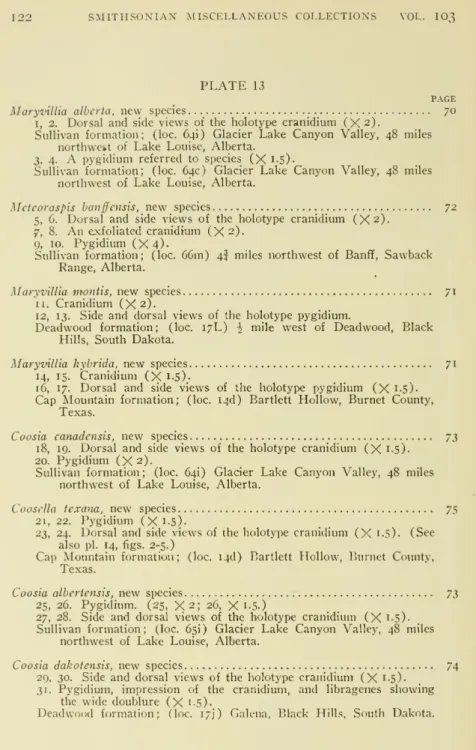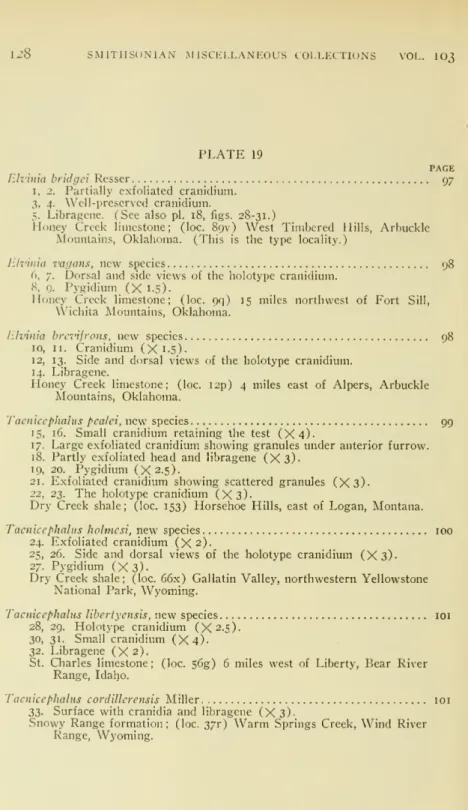Only some of the genera represented by the species described in this article can be referred to higher taxonomic categories. Komaspidae was a poor selection as a family name, because both Chariocephalus and Irvingella are much more characteristic of the family than the obscure Komaspis.
6 SMITHSOXIAX MISCELLANEOUS COLLECTIONS VOL. IO3 The glabella is slightly expanded and the anterior angles are rounded
The pleural lobes form triangular platforms that slope toward the slightly flattened margin, which becomes quite narrow posterior to the axis. The eyes are very long and extend from the occipital furrow beyond the lateral course of the facial suture, therefore exceeding the glabella in length.
8 SMITHSONIAN MISCELLANEOUS COLLECTION'S VOL. IO3
The pygidium assigned to the species has a broad axis with three well-defined rings and stands completely above the pleural platforms. The associated pygidium assigned to the species has a moderately high axis and a relatively narrow pleural platform.
10 SMITHSONIAN MISCELLANEOUS COLLECTIONS VOL. IO3
The fixigenes at their widest point are about half the width of the glabella, and the long eyes have an almost circular curvature. Fixigenes, confined to the palpebral lobes, are at their widest point less than half the width of the glabella.
IRVINGELLA ULRICH AND RESSER, 1924
In cross-section, the entire skull is somewhat flat, and the palpebral lobes slope slightly from the dorsal furrow.
14 SMITHSONIAN MISCELLANEOUS COLLECTIONS VOL. IO3
The faxigene are more than half the width of the glabella and the eyes are very long and extend from the occipital. The glabella tapers, due to the even convergence of the dorsal furrow from the occipital furrow forward.
22 SMITHSONIAN MISCELLANEOUS COLLECTIONS VOL. IO3
Fixgene more than half the width of the glass leaves, which in their front parts decrease to the width of the edge. Laterally, the convexity of the glabella is greatly reduced, although longitudinally it curves evenly.
26 SMITHSONIAN MISCELLANEOUS COLLECTIONS VOL. 10^
The fixigens are less than one-third the width of the glabella at their widest point. Fixigenes narrow, at the widest point a little more than one-fourth the width of the glabella.
UNCLASSIFIED GENERA CHEILOCEPHALUS Berkey, 1898
The cranium is wider than long and, excluding the posterolateral limbs, is rectangular in outline. The eyes are of moderate size, located slightly in front of the median point of the cranidium.
42 SMIIIISOXIAX MISCEI-LANEOUS COLLECTION'S VOL. IO3
The comparison shows that, although typical of the genus in every respect, the pygidium is broader than that of M. So far Arapahoia appears to be confined to horizons in the lower part of the Cedaria zone, and is the oldest genus of this group.
44 SMITIISOXIAN MISCELI.ANKOUS COLLECTION'S VOL. I03
The cranidium, except for the large occipital spine and posterolateral limbs, forms approximately a rectangle. The facial suture diverges sharply before the eye and sharply behind the eye to form large posterolateral limbs.
46 SMITHSONIAN MISCELLANEOUS COLLECTIONS VOL. IO3
The suture diverges in front of the eye to form large posterolateral limbs behind the eye. In cross section the skull is very convex; the convexity is achieved by the steeply sloping posterolateral limbs and a very sharp bend at the top of the glabella.
50 SMITHSONIAN MISCELLANFOUS COLLECTIONS VOL. IO3
Cecil Kindle, who collected the cranidium and several pygidia from the belt of Warrior limestone exposed in the southwestern part of the Bellefonte Quadrangle. The distinguishing features, as with other species, lie mainly in the proportions of the edge. The glabella is large and relatively wide, so that it takes up by far the largest part of the skull.
In posterior view, the glabella stands above the posterolateral limbs due to deep notches in the posterior margin at the ends of the dorsal furrow.
58 SMITHSONIAN* MISCELLANEOUS COLLECTIONS VOL. IO3
In cross-section, the skull is convex, reaching greatest curvature as it approaches the midline. The ridge width is just over one-fourth of the glabellar length and is a simple convex band surrounding the front of the head. By mimia elongation of the Kingstonia stem, but in Sienopilus this is accompanied by obesity and the elimination of all furrows.
The margin is thickened and widens in the middle to about twice the width of the preglabellar area.
62 SMITHSONIAN MISCELLANEOUS COLLECTIONS VOL. IO3 area separates the thickened, striated rim from the dorsal furrow
Since the very heavy eyestripes are elevated, most of the fixation can lie below the level of the dorsal and eye grooves. The axis is one-half to two-thirds the length of the pygidium and rests on the dorsal groove. In fact, the outer borders of the genitals are curved up and back at the genital angles so that.
Heavy eyelines connect the large raised eyebands with the dorsal front data point in front of the anterior pair of glabellar furrows.
66 SMITHSONIAN MISCELLANEOUS COLLECTIONS VOL. IO3 reduced, consisting only of a slightly elevated portion of the fixigenes
The rim is narrower than the neck ring, a feature common to several of the Canadian species. The width of the rim is equal to half the length of the glabella, excluding the occipital ring. The rim width is equal to about haU the length of the glabella, including the occipital ring.
A prominent pygidial axis occupies three-quarters of the length of the pygidium and has a postaxial ridge that extends practically to the posterior margin.
NO. 5 UPPER CAMBRIAN TRILOBITES — RESSER 73
Furrows are visible on the axis and in the anterior parts of the pleural platforms. Margin not wide and shorter than half glabellar length without neck. At the anterior end of the eye, the fixigenes are about a third of the width of the glabella.
In width, the rim is only half the length of the glabella including the neck ring.
86 SMITHSONIAN M ISCKI.LANEOUS COLLECTIONS VOL. IO3 characterized by a normal glabella on which two pairs of furrows are
The width of the shadow is almost equal to the length of the glabella excluding the neck ring. The shadow is almost as wide as the length of the glabella excluding the occipital ring. At the anterior end of the eye, the fixigenes are less than half the glabellar width.
At the anterior end of the eye, the fixigen is less than half the width of the glabella.
90 SMITHSONIAN M ISCELI.ANEOUS COLLECTIONS VOL. IO3 upon close examination it appears to be merely a simplification of
5 UPPER CAMBRIAN TRILOBITES RESSER 9I to sharp depression of anterior angles, divergence of anterior facial suture not evident. Behind the eyes, the postero-lateral arms, also strongly indented, are about three times the size of the occipital ring. Although this species is not entirely typical of the genus, the margin being narrower than the preglabellar surface, the difference in appearance may be due to the fact that the test is preserved in these specimens.
With compression of the anterior angles and posterolateral limbs, both the anterior and posterior parts of the cranidium reach a considerable convexity.
92 SMITHSONIAN MISCELLANEOUS COLLECTIONS VOL. IO3 Features which make this an average species of the genus include
Its aspect is due to the relatively long glabella and the angulation of the anterior margin. Both the anterior angles and the posterolateral limbs are sharply downwards so that in dorsal view the strong curve of the rim is exaggerated. It is in all respects typical of the genus, and corresponds quite closely to those Oklahoma species characterized by the wide pre-glabellar area.
The very narrow fixigenes at the anterior end of the eye are only about a quarter as wide as the glabella.
UNCLASSIFIED GENERA
The rim, which occupies almost a third of the length of the skull, is divided into a thickened rim and a slightly wider convex preglabellar region. It is not certain that the larger and smaller cranidia depicted here belong to the same species, as none of the smaller heads exist. The rim, almost exactly one-third of the skull length, has a slightly thickened rim that is considerably narrower than the preglabellar region.
At the anterior end of the eye, the fixigens are considerably more than half the glabellar width.
98 SMITHSONIAN MISCELLANEOUS COLLECTIONS VOL. IO3 Additional specimens of this species are figured to illustrate char-
Longitudinally, the convexity is greater, but is also even, apart from a slight flattening of the rim towards the horizontal position. They are very strongly bent longitudinally, which, together with the distinctness of the palpebral lobe, projects the eyes considerably above the rest of the cranium. This rather large species found in the northeastern part of Yellowstone National Park differs from T.
The species is characterized by normal shape and development of the several parts, with the possible exception of a flattening in the preglabellar area.
102 SMITHSONIAN MISCELLANEOUS COLLECTIONS VOL. IO3
5 BUCHAMBRIAN TRILOBITES RESSER IO3 Longitudinally the relief of the cranidium is not large but because both the dorsal and anterior furrows are deep the relative relief is. In cross section the convexity of the glabella and sharp rise of the fixigenes towards the eyes as well as sharp depression of anterior angles and posterolateral limbs. The fixigenes are fairly evenly covered by granules, but only a few are found on the more elevated parts of the glabella.
The border is approximately two-thirds the width of the preglabellar region in the center.
104 SMITHSONIAN MISCELLANEOUS COLLECTIONS VOL. IO3
In front of the eyes the divergence of the suture is not great, which leaves only moderate anterior angles. At the center, the width of the rim is slightly less than half the glabellar length, including the occipital ring. A second species from Texas is characterized by being shorter and by the resulting glabella occupying a relatively larger portion of the cranidium.
A prominent, slightly thickened ridge widens posteriorly in the center, significantly reducing the width of the preglabellar area.
EXPLANATION OF PLATES
IIO SMITHSONIAN MISCELLANEOUS COLLECTIONS VOL. I03
Honey Creek kalksten; (loc. Sgw) vestsiden af West Timbered Hills, Arbuckle Mountains, Oklahoma.
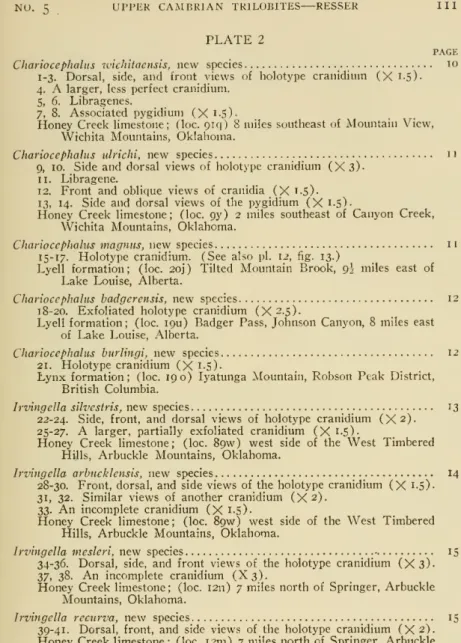
112 SMITHSONIAN MISCELLANEOUS COLLECTIONS VOL. IO3
UPPER CAMBRIAN TRILOBITES
Front, side, and dorsal views of holotype cranidium (X3) - Secret Canyon shale; (loc. 60) near Richmond Mine, Eureka District,. Dorsal, frontal, and lateral views of holotype cranidium (X3) - Secret Canyon shale; (loc. 61) south of Hamburg Mine, Eureka Dis-. Lateral and dorsal views of holotype cranidium (Xi-S) - Secret Canyon shale; (Iocs. 62, 63) north of Adams Hill, Eureka.
114 SMITHSONIAN MISCELLANEOUS COLLECTIONS VOL. I03
Dorsal and profile views of holotype cranidium (Xi-S)- Sullivan Formation; (local. 64h) East Lyell Glacier, 48 miles northwest. Dorsal and lateral views of holotype cranidium (X4)- Sullivan Formation; (loc. 6ir) Moose River, 10 miles northeast of. Dorsal and lateral views of holotype cranidium (XS) - Sullivan Formation; (loc. 64i) Glacier Lake Canyon Valley, 48 miles.
Lateral and dorsal views of the holotype cranidium (Xs)-Sullivan formation; (loc. 64s) Ranger Brook Canyon, Sawback Range.
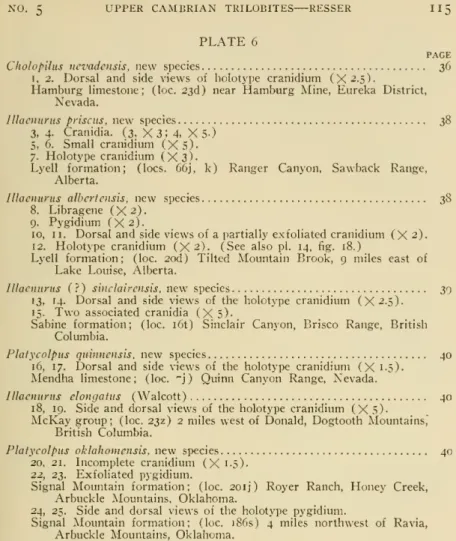
43 Upper Cambrian Trilobites
UPPER CAMBRIAN TRIUOBITES
the formation of Lyell; (loc. 66j) Northeast Branch Ranger Brook Canyon, 10 miles northwest of Banff, Sawback Range, Alberta. Lateral and dorsal views of holotype cranidium (XS)- Formation of mountain signal; (loc. aoij) i mile south of Royer Ranch,.
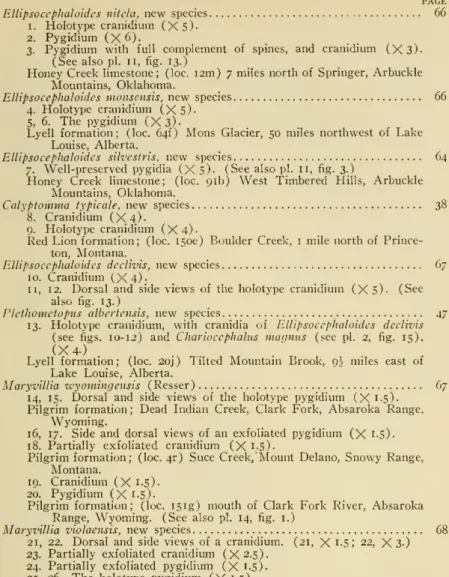
122 SMITHSONIAN MISCELLANEOUS COLLECTIONS VOL. I03
Dorsal and lateral views of holotype cranidium (XS)- Guriorlimestone; (loc. 38e) one thousandth NW of Benore, 5 miles W. Limestone Mendha; (loc. 7J) mile north of Italian Ranch foothills, north end of Quinn Canyon Range, Nevada.
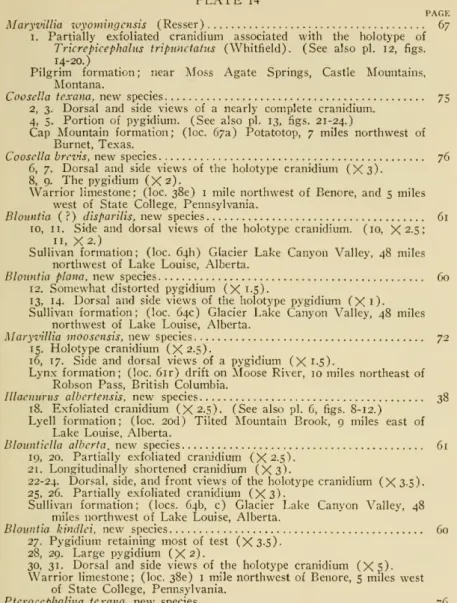
124 SMITHSONIAN MISCELLANEOUS COLLECTIONS VOL. I03
39 Upper Cambrian Triuobites
Print, side and dorsal views of holotype cranidium (Xi-S) - Honey Creek Limestone; (loc. 9q) Blue Creek Canyon, Wichita Moun-.
126 SMITHSONIAN MISCELLANEOUS COLLECTIONS VOL. IO3
128 SMITHSONIAN MISCELLANEOUS COLLECTIONS VOL. I03
Honey Creek Limestone; (loc. Qq) Blue Creek Canyon, 15 miles northwest of Fort Sill, Wichita Mountains, Oklahoma.
INDEX
132 INDEX
INDEX 133
134 INDEX
INDEX 135
136 INDEX
